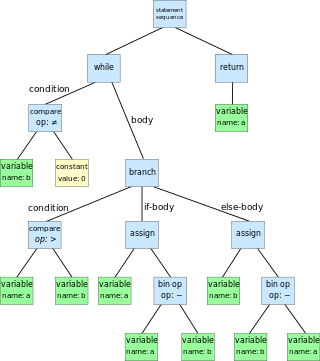Related Research Articles

Martin Fowler is a British software developer, author and international public speaker on software development, specialising in object-oriented analysis and design, UML, patterns, and agile software development methodologies, including extreme programming.

In computer programming, an S-expression is an expression in a like-named notation for nested list (tree-structured) data. S-expressions were invented for and popularized by the programming language Lisp, which uses them for source code as well as data.
In computer science, a compiler-compiler or compiler generator is a programming tool that creates a parser, interpreter, or compiler from some form of formal description of a programming language and machine.

An abstract syntax tree (AST) is a data structure used in computer science to represent the structure of a program or code snippet. It is a tree representation of the abstract syntactic structure of text written in a formal language. Each node of the tree denotes a construct occurring in the text. It is sometimes called just a syntax tree.

A parse tree or parsing tree or derivation tree or concrete syntax tree is an ordered, rooted tree that represents the syntactic structure of a string according to some context-free grammar. The term parse tree itself is used primarily in computational linguistics; in theoretical syntax, the term syntax tree is more common.
In computer science, pattern matching is the act of checking a given sequence of tokens for the presence of the constituents of some pattern. In contrast to pattern recognition, the match usually has to be exact: "either it will or will not be a match." The patterns generally have the form of either sequences or tree structures. Uses of pattern matching include outputting the locations of a pattern within a token sequence, to output some component of the matched pattern, and to substitute the matching pattern with some other token sequence.
Parsing, syntax analysis, or syntactic analysis is the process of analyzing a string of symbols, either in natural language, computer languages or data structures, conforming to the rules of a formal grammar. The term parsing comes from Latin pars (orationis), meaning part.
An attribute grammar is a formal way to supplement a formal grammar with semantic information processing. Semantic information is stored in attributes associated with terminal and nonterminal symbols of the grammar. The values of attributes are result of attribute evaluation rules associated with productions of the grammar. Attributes allow to transfer information from anywhere in the abstract syntax tree to anywhere else, in a controlled and formal way.
Tree-adjoining grammar (TAG) is a grammar formalism defined by Aravind Joshi. Tree-adjoining grammars are somewhat similar to context-free grammars, but the elementary unit of rewriting is the tree rather than the symbol. Whereas context-free grammars have rules for rewriting symbols as strings of other symbols, tree-adjoining grammars have rules for rewriting the nodes of trees as other trees.
In computer science, graph transformation, or graph rewriting, concerns the technique of creating a new graph out of an original graph algorithmically. It has numerous applications, ranging from software engineering to layout algorithms and picture generation.
Extensible programming is a term used in computer science to describe a style of computer programming that focuses on mechanisms to extend the programming language, compiler and runtime environment. Extensible programming languages, supporting this style of programming, were an active area of work in the 1960s, but the movement was marginalized in the 1970s. Extensible programming has become a topic of renewed interest in the 21st century.
In computer science, higher-order abstract syntax is a technique for the representation of abstract syntax trees for languages with variable binders.
A program transformation is any operation that takes a computer program and generates another program. In many cases the transformed program is required to be semantically equivalent to the original, relative to a particular formal semantics and in fewer cases the transformations result in programs that semantically differ from the original in predictable ways.

In computer science, the syntax of a computer language is the rules that define the combinations of symbols that are considered to be correctly structured statements or expressions in that language. This applies both to programming languages, where the document represents source code, and to markup languages, where the document represents data.
The DMS Software Reengineering Toolkit is a proprietary set of program transformation tools available for automating custom source program analysis, modification, translation or generation of software systems for arbitrary mixtures of source languages for large scale software systems. DMS was originally motivated by a theory for maintaining designs of software called Design Maintenance Systems. DMS and "Design Maintenance System" are registered trademarks of Semantic Designs.
XPath is an expression language designed to support the query or transformation of XML documents. It was defined by the World Wide Web Consortium (W3C) in 1999, and can be used to compute values from the content of an XML document. Support for XPath exists in applications that support XML, such as web browsers, and many programming languages.
The syntax and semantics of Prolog, a programming language, are the sets of rules that define how a Prolog program is written and how it is interpreted, respectively. The rules are laid out in ISO standard ISO/IEC 13211 although there are differences in the Prolog implementations.
In mathematical logic, a term denotes a mathematical object while a formula denotes a mathematical fact. In particular, terms appear as components of a formula. This is analogous to natural language, where a noun phrase refers to an object and a whole sentence refers to a fact.
LibSBML is an open-source software library that provides an application programming interface (API) for the SBML format. The libSBML library can be embedded in a software application or used in a web servlet as part of the application or servlet's implementation of support for reading, writing, and manipulating SBML documents and data streams. The core of libSBML is written in ISO standard C++; the library provides API for many programming languages via interfaces generated with the help of SWIG.
A term graph is a representation of an expression in a formal language as a generalized graph whose vertices are terms. Term graphs are a more powerful form of representation than expression trees because they can represent not only common subexpressions but also cyclic/recursive subexpressions.
References
- ↑ Garner, Richard (2011). "An abstract view on syntax with sharing". Journal of Logic and Computation. 22 (6): 1427–1452. arXiv: 1009.3682 . doi:10.1093/logcom/exr021.
The notion of term graph encodes a refinement of inductively generated syntax in which regard is paid to the sharing and discard of subterms.
- ↑ Plump, D. (1999). Ehrig, Hartmut; Engels, G.; Rozenberg, Grzegorz (eds.). Handbook of Graph Grammars and Computing by Graph Transformation: applications, languages and tools. Vol. 2. World Scientific. pp. 9–13. ISBN 9789810228842.
- ↑ Barendregt, H. P.; van Eekelen, M. C. J. D.; Glauert, J. R. W.; Kennaway, J. R.; Plasmeijer, M. J.; Sleep, M. R. (1987). "Term graph rewriting". PARLE Parallel Architectures and Languages Europe. Lecture Notes in Computer Science. Vol. 259. pp. 141–158. doi:10.1007/3-540-17945-3_8. ISBN 978-3-540-17945-0.
{{cite book}}:|journal=ignored (help)